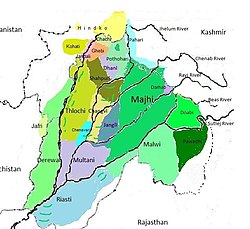
Back মাঝা Bengali/Bangla Majha Spanish Majha French माझा Hindi മജ്ഹ Malayalam ମାଝା OR ਮਾਝਾ Punjabi ماجھا PNB ماجھو Sindhi மாஜ்ஹா Tamil

| Part of a series on |
| Punjabis |
|---|
 |
 Punjab portal |
Majha (Punjabi: ਮਾਝਾ (Gurmukhi), ماجھا (Shahmukhi) also known as Standard Punjabi or simply Punjabi; Mājhā; Punjabi pronunciation: [mä́ː.dʒäː]; meaning "heartland[1]) is a region located in the central parts of the historical Punjab region split between India and Pakistan.[2][1] It extends north from the right banks[note 1] of the river Beas, and reaches as far north as the river Jhelum.[3] People of the Majha region are given the demonym "Mājhī" or "Majhail". Most inhabitants of the region speak the Majhi dialect, which is the basis of the standard register of the Punjabi language.[4] The most populous city in the area is Lahore on the Pakistani side, and Amritsar on the Indian side of the border.
During the partition of India in 1947, the Majha region of Punjab was split between India and Pakistan when the Indian Punjab and Pakistani Punjab were formed. The Majha region of Indian State of Punjab covers the area between Beas and Ravi rivers, including the area on the north of Sutlej, after the confluence of Beas and Sutlej at Harike in Tarn Taran district, extending up to the Ravi River, which is all part of the Majha region in India.[5] This region contains fourteen districts of the Pakistani province of Punjab, including the cities of Lahore, Faisalabad, Sahiwal, Pakpattan, Gujranwala, Gujrat, and Sialkot. It includes four districts of Indian state of Punjab – Amritsar, Tarn Taran, Gurdaspur, and Pathankot.
The people of the Majha region have been historically known for their warrior-like nature. The Majha region is called the "Sword Arm of the Country", due to it contributing disproportionately to the Officer as well as Orderly ranks of the Armies of both India and Pakistan.[6] The Sikh Empire was founded in the Majha region, and so the region is also sometimes referred to as "the cradle of the brave Sikhs".[7] Majha is also the birthplace of Sikhism.[8]
- ^ a b Grover, Parminder Singh; Singh, Davinderjit (2011). "Section 1: Introduction – Regions of Punjab". Discover Punjab: Attractions of Punjab. Photographs by Bhupinder Singh. Ludhiana, Punjab, India and Berlin: Golden Point Pvt Lmt.
Regions of Punjab: The much-truncated India's portion of present Punjab is divided into three natural regions: The Maiha, The Doaba, The Malwa. Majha: Majha starts northward from the right bank of river Beas and stretches up to the Wagha village, which marks the boundary between India and India. Majha in Punjabi means the heartland. The region is divided into three districts: 1. Amritsar, 2. Gurdaspur, 3. Tarn Taran. Doaba: The rivers Sutlei in the south and Beas in the North bound the Doaba of Puniab. The Doaba region is divided into four districts: 1. Jalandhar, 2. Nawanshahr, 3. Kapurthala, 4. Hoshiarpur. Malwa: The area south of the river Sutlej is called Malwa. The name has stuck because a clan called Molois (sometimes written as Malawis in ancient works) once ruled this area, which must have spread up to present State of Gujrat which was known as the Subah of Malwa as late as the Mughul times. Malwa the largest part of the Punjab is divided into the following 12 districts after the names of their headquarters: 1. Bathinda, 2. Barnala, 3. Faridkot, 4. Fatehgarh Sahib, 5. Ferozepur, 6. Ludhiana, 7. Mansa, 8. Moga, 9. Sangrur, 10. Muktsar, 11. Patiala, 12. Rup Nagar, 13. SAS Nagar - Mohali.
- ^ Discover India http://www.discoveredindia.com/punjab/about-punjab/regions-in-punjab.htm
- ^ Grover, Parminder Singh (2011). Discover Punjab: Attractions of Punjab. Parminder Singh Grover. p. 179.
- ^ Advanced Centre for Technical Development of Punjabi Language, Literature and Culture, Punjabi University, Patiala Punjabi University, Patiala.
- ^ Punjab Data, Know Everything About Punjab https://www.trendpunjabi.com/majha-malwa-doaba/
- ^ Mahmood, Cynthia Keppley (1996). Fighting for Faith and Nation: Dialogues with Sikh Militants (Contemporary Ethnography), p. 153. Philadelphia, University of Pennsylvania.
- ^ Sandhu, Gulzar Singh (2004). Gods on Trial and Other Stories, p. 132. Diamond Pocket Books. ISBN 8128808087
- ^ "MAJHA". 19 December 2000.
Cite error: There are <ref group=note> tags on this page, but the references will not show without a {{reflist|group=note}} template (see the help page).
© MMXXIII Rich X Search. We shall prevail. All rights reserved. Rich X Search